
Homemaking is mainly an American and Canadian term for the management of a home, otherwise known as housework, housekeeping, housewifery or household management. It is the act of overseeing the organizational, day-to-day operations of a house or estate, and the managing of other domestic concerns. A person in charge of the homemaking, who is not employed outside the home, in the US and Canada, is called a homemaker, a term for a housewife or a househusband. Historically the role of homemaker was often assumed by women. The term "homemaker", however, may also refer to a social worker who manages a household during the incapacity of the housewife or househusband. Home health workers assume the role of homemakers when caring for elderly individuals. This includes preparing meals, giving baths, and any duties the person in need cannot perform for themselves.

A dishwasher is a machine that is used to clean dishware, cookware, and cutlery automatically. Unlike manual dishwashing, which relies heavily on physical scrubbing to remove soiling, the mechanical dishwasher cleans by spraying hot water, typically between 45 and 75 °C, at the dishes, with lower temperatures of water used for delicate items.

A detergent is a surfactant or a mixture of surfactants with cleansing properties when in dilute solutions. There are a large variety of detergents, a common family being the alkylbenzene sulfonates, which are soap-like compounds that are more soluble in hard water, because the polar sulfonate is less likely than the polar carboxylate to bind to calcium and other ions found in hard water.

Hygiene is a series of practices performed to preserve health. According to the World Health Organization (WHO), "Hygiene refers to conditions and practices that help to maintain health and prevent the spread of diseases." Personal hygiene refers to maintaining the body's cleanliness. Hygiene activities can be grouped into the following: home and everyday hygiene, personal hygiene, medical hygiene, sleep hygiene and food hygiene. Home and every day hygiene includes hand washing, respiratory hygiene, food hygiene at home, hygiene in the kitchen, hygiene in the bathroom, laundry hygiene and medical hygiene at home.
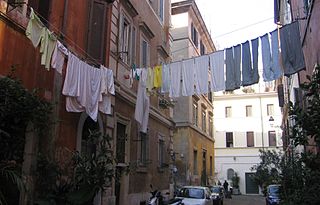
Laundry refers to the washing of clothing and other textiles, and, more broadly, their drying and ironing as well. Laundry has been part of history since humans began to wear clothes, so the methods by which different cultures have dealt with this universal human need are of interest to several branches of scholarship. Laundry work has traditionally been highly gendered, with the responsibility in most cultures falling to women. The Industrial Revolution gradually led to mechanized solutions to laundry work, notably the washing machine and later the tumble dryer. Laundry, like cooking and child care, is still done both at home and by commercial establishments outside the home.

A laundry symbol, also called a care symbol, is a pictogram indicating the manufacturer's suggestions as to methods of washing, drying, dry-cleaning and ironing clothing. Such symbols are written on labels, known as care labels or care tags, attached to clothing to indicate how a particular item should best be cleaned. While there are internationally recognized standards for the care labels and pictograms, their exact use and form differ by region. In some standards, pictograms coexist with or are complemented by written instructions.

A washing machine is a home appliance used to wash laundry. The term is mostly applied to machines that use water as opposed to dry cleaning or ultrasonic cleaners. The user adds laundry detergent, which is sold in liquid or powder form, to the wash water.

A mangle or wringer is a mechanical laundry aid consisting of two rollers in a sturdy frame, connected by cogs and powered by a hand crank or by electricity. While the appliance was originally used to wring water from wet laundry, today mangles are used to press or flatten sheets, tablecloths, kitchen towels, or clothing and other laundry.

A scullery is a room in a house, traditionally used for washing up dishes and laundering clothes, or as an overflow kitchen. Tasks performed in the scullery include cleaning dishes and cooking utensils, occasional kitchen work, ironing, boiling water for cooking or bathing, and soaking and washing clothes. Sculleries contain hot and cold sinks, sometimes slop sinks, drain pipes, storage shelves, plate racks, a work table, various coppers for boiling water, tubs, and buckets.
A fabric softener or fabric conditioner is a conditioner that is applied to laundry during the rinse cycle in a washing machine to reduce harshness in clothes that are dried in air after machine washing. In contrast to laundry detergents, fabric softeners may be regarded as a kind of after-treatment laundry aid.
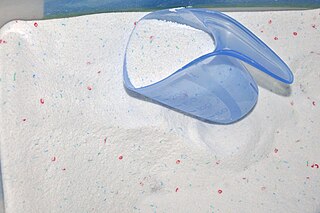
Laundry detergent is a type of detergent used for cleaning dirty laundry (clothes). Laundry detergent is manufactured in powder and liquid form.
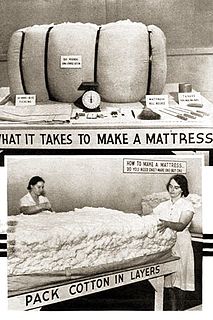
Ticking is a type of cloth, traditionally a tightly-woven cotton or linen textile. It is traditionally used to cover tick mattresses and bed pillows. The tight weave makes it more durable and hinders the stuffing from poking through the fabric. To make it even tighter, ticking could be waxed, soaped, or starched. Tick materials designed to hold foam may be knit, or more porous. In English-speaking countries ticking commonly has a striped design, in muted colors such as brown, grey or blue, and occasionally red or yellow, against a plain, neutral background.
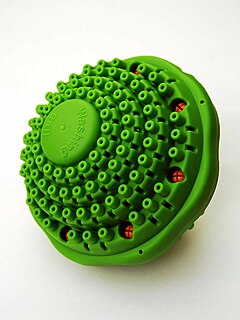
A laundry ball or washing ball is a product made of solid, insoluble material promoted as a substitute for laundry detergent. Producers of laundry balls often make pseudoscientific claims about their mechanisms of action and exaggerate the extent of their benefits.

Ironing is the use of a machine, usually a heated tool, to remove wrinkles and unwanted creases from fabric. The heating is commonly done to a temperature of 180–220 °Celsius, depending on the fabric. Ironing works by loosening the bonds between the long-chain polymer molecules in the fibres of the material. While the molecules are hot, the fibres are straightened by the weight of the iron, and they hold their new shape as they cool. Some fabrics, such as cotton, require the addition of water to loosen the intermolecular bonds. Many modern fabrics are advertised as needing little or no ironing. Permanent press clothing was developed to reduce the ironing necessary by combining wrinkle-resistant polyester with cotton.

The Thor washing machine was the first electric clothes washer sold commercially in the United States. Produced by the Chicago-based Hurley Electric Laundry Equipment Company, the 1907 Thor is believed to be the first electrically powered washer ever manufactured, crediting Hurley as the inventor of the first automatic washing machine. Designed by Hurley engineer Alva J. Fisher, a patent for the new electric Thor was issued on August 9, 1910, three years after its initial invention.

The washing paddle, known as thaapi in Haryanvi and Hindi languages, is a hand tool used to do laundry. It is made of wood, shaped like a baker's peel, but with a much shorter handle used as a grip. It was used to beat the wet clothes and linens, pushing out the dirt by hammering the items against the washboard, or against the flat slabs built into the laundry area.
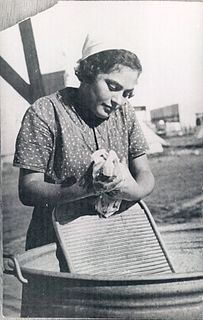
A washboard is a tool designed for hand washing clothing. With mechanized cleaning of clothing becoming more common by the end of the 20th century, the washboard has become better known for its secondary use as a musical instrument.
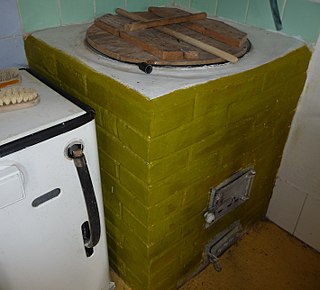
A wash copper, copper boiler or simply copper is a wash house boiler, generally made of galvanised iron, though the best sorts are made of copper. In the inter-war years they came in two types. The first is built into a brickwork furnace and was found in older houses. The second was the free-standing or portable type, it had an enamelled metal exterior that supported the inner can or copper. The bottom part was adapted to hold a gas burner, a high pressure oil or an ordinary wood or coal fire. Superior models could have a drawing-off tap, and a steam-escape pipe that lead into the flue.

















